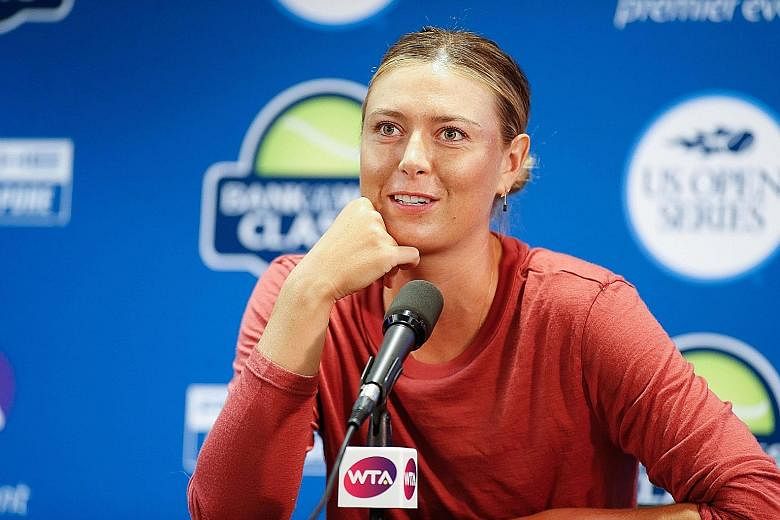As unlikely as it might seem, Maria Sharapova and Tiger Woods are creations of American culture.
Their headlines this week show them heading down differing paths. Sharapova, Russian by birth but prepared for United States stardom since she was seven, has been granted a wild card straight into the US Open main draw just in time for the launch of her book, Unstoppable: My Life So Far.
Her tennis world ranking is No. 148, though she is a former winner at Flushing Meadows in Queens, New York City.
Woods appears far from a comeback. The sheriff's office in Palm Beach has released a toxicology report showing that he had five different drugs in his system on the night US police found the golfer behind the wheel of his stationary Mercedes on a Florida road in May.
In one sense, these two sporting icons cross the colour issue that is re-emerging across the United States. Apart from riches and aside from having been the best in their respective sports, the black American and the white Russian, whose father spent his last rouble to take her to America at such a tender age, show how even the best in sports appear ignorant of what goes into their body.
That truly astonishes me.
How could Sharapova have taken meldonium, a drug prescribed for heart conditions in Russia, for years without someone in her support team questioning the ethics of such a substance in someone at the top of her game?

Why would Woods, one of the foremost Americans of his time, swallow such a scary cocktail of drugs into a body that he still hopes to get back into shape to challenge for Majors again?
We know that his back is ailing. We hear that he suffers not only from pain but also insomnia. But two painkilling drugs, Vicodin and Dilaudid? And two sleeping drugs, Xanax and Ambien? Plus a muscle relaxer that reportedly has similar effects to marijuana?
It makes one shudder to read the list released by the sheriff's office.
Woods, 41, reiterated in a statement released by his agency that he received professional help to manage his medications. But recently, another statement read, "I had been trying on my own to treat my back pain and a sleep disorder."
The statement brings chilling memories of pop icon Michael Jackson's fatal overdose in 2009. And of too many singers and former stars of the stage, the silver screen and sports, whose autopsy reports confirmed that drug abuse caused their premature demise.
They could afford, even in America, to pay for top medical expertise before taking anything that could harm, let alone kill, their most precious attributes - the mind and body.
Yet living in England, and I'm sure in some other parts of the world too, the attitude seems to be what's good for America can only be good for us too.
Sharapova and Woods are the latest in sports to cross that line between good and self-wounding.
Each had a gift spotted in infancy. Each was pushed by their father. Each got the boost that corporate America provides to child stars.
In Sharapova's case, dad Yuri rustled up the money to take his child to the US (without her mother, who could not afford to join them for the first two years).
It was a hard grind for father and daughter. He washed dishes, she joined the unforgiving juniors on court for hour after hour, day after day against all the other kids at the Nick Bollettieri Tennis Academy.
Soon, IMG, the agency built on the fame of Arnold Palmer and Jack Nicklaus, sponsored her. Nike too.
IMG and Nike are as good at spotting prodigious athletic talent as the theatrical agencies once were in taking Shirley Temple, Judy Garland and Mickey Rooney from vaudeville to Hollywood as child actors.
Sharapova is no dumb blonde either. By the time she was nine, she was becoming less Russian and more American in the making. Now 30, she has served her tennis ban and will be back in a Grand Slam.
The enforced rest was put to good commercial gain, boosting her brands in anything from cosmetics to Sugarpova.
Her "premium chocolate" range, aimed at sweet-toothed kids, sells the goods of an Illinois confectioner at between US$3 and US$5 (S$4.10 and US$6.80) a piece. She even took a short course at Harvard University last year to sharpen her business acumen.
And, of course, she wrote her memoir, Unstoppable.
The tennis world remains ambivalent towards her. Serena Williams, herself planning to return at the Australian Open next January after the birth of her first child next month, is not a fan of the shortened sentence granted to Sharapova.
However, the Court of Arbitration for Sport ruled that she had been prescribed the drug by her family doctor in Russia and taken it in good faith. The jury is out as to its use in sports.
The inventor of meldonium, Ivars Kalvins, claims it is popular both among athletes and the Russian military, and that his drug "optimises the use of oxygen... allowing athletes to train under maximum strain".
Others, in the US, insist that there is no evidence of any performance-enhancing property to the drug.
This is a familiar, yet fuzzy dichotomy between sports and prohibited substances.
We imagine that they are banned for a reason, though meldonium was only added to the list of World Anti-Doping Agency's banned drugs from January 2016.
Sharapova's other claim to innocence was that she had failed to read the warning, issued by e-mail, that this particular pill was banned.
We may assume that athletes know their body, and know every last detail of what goes in and what should not.
Sharapova and Woods put up ignorance as their first line of defence.
And whether or not we believe them is immaterial.
They were once so close to the summit of physical attainment that it is unnerving to read that they risked everything, including their health, on popping pills.


